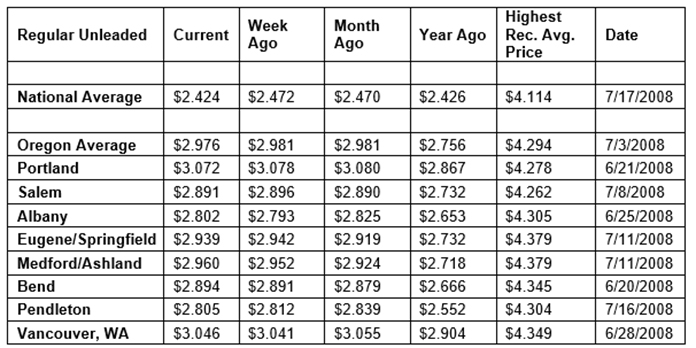Crude oil prices have fallen as the markets react to the growing impact of the coronavirus and fears that the virus will lead to a global economic slowdown. That’s helping fuel prices remain stable or even drop at a time of year when we normally start to see pump prices rise.
For the week, the national average for regular loses a nickel to $2.42 a gallon. The Oregon average ticks down half a cent to $2.98. The average price in Hermiston is around $2.79.
Pump prices rose in some West Coast markets last week after an explosion and fire at the West Coast’s largest oil refinery in Carson, California, near Los Angeles. The Marathon facility has a capacity of 363,000 barrels a day. Last Wednesday, Marathon issued a statement that the fire was quickly contained. The situation did not end up having a lasting impact on prices in the state or the region.
“This is normally the time of year we start to see gas prices rise due to refinery maintenance season and the upcoming switchover to summer-blend fuels. However, the impact of the coronavirus could keep demand lower than usual which may temper increasing pump prices,” says Marie Dodds, public affairs director for AAA Oregon/Idaho.
Oregon is one of 46 states and Washington D.C. where prices are lower now than a week ago. Ohio (-16 cents) has the largest weekly decline in the country. Idaho (+3 cents) has the largest week-over-week increase.
This week there are three states with an average above $3 a gallon, same as a week ago.
The cheapest gas in the nation can be found in Texas ($2.11) and Mississippi ($2.12). For the 55th week in a row, no states have an average below $2 a gallon.
Oregon is one of 41 states and the District of Columbia with lower prices now than a month ago. The national average is five cents less and the Oregon average is half a cent less than a month ago. Colorado (-18 cents) has the largest month-over-month decline. Delaware (+9 cents) has the largest monthly increase.
Oregon is one of 27 states where drivers are paying more than a year ago. The national average is the same and the Oregon average is 22 cents more than a year ago. This is the fifth-largest yearly increase in the nation. Arizona (+33 cents) and Utah (+31 cents) have the biggest year-over-year increases.










